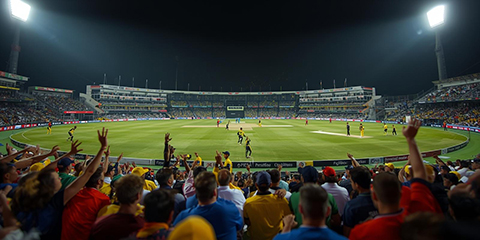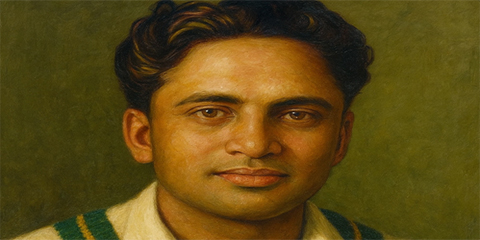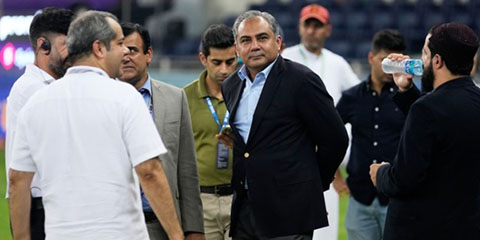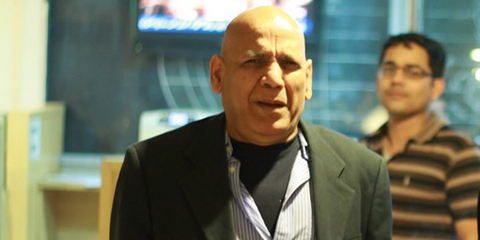Pakistan vs India Asia Cup 2025: The handshake controversy that masked bigger ICC code violations
JournalismPakistan.com | Published 2 months ago | Dr. Nauman Niaz (TI)
Join our WhatsApp channel
ISLAMABAD — On September 14th, 2025, under the unrelenting glare of floodlights and television beams, Pakistan stumbled through the sixth match of the Asia Cup. They lost, not only by six wickets, but by the manner of their cricket, a display abysmal enough to invite not analysis but lament. Yet it was not their slackened strokes or their faltering lengths that left the deeper bruise. The controversy that unfolded off the field, tangled in ritual, politics, and provocation, turned a cricket match into something darker, something nearer theatre than sport.
Andy Pycroft's Controversial Handshake Instruction
At the toss, it emerged, Andy Pycroft, once of Zimbabwe, now entrusted with neutrality, the ICC Match Referee, had leaned toward Salman Ali Agha, Pakistan's captain, with counsel unusual and unseemly: 'do not shake the hand of Suriyakumar Yadav'. A gesture as old as cricket itself, denied, distorted, contrary to the spirit of the game. What followed carried the tone not of cricket's timeless courtesy but of a script rehearsed elsewhere.
From Cricket Victory to Political Sermon
For when India triumphed, Suriyakumar, bat still fragrant with the sweat of its labour, did not linger in the realm of the cricketer. He ascended instead into the role of envoy, a messenger of politics rather than of play. His words, uttered into the waiting microphone, did not dwell upon the arc of partnerships, nor upon the subtle turn of fortune's wheel. They were consecrated to another theatre: to the Indian Army, to the lament of Pahalgam, Jammu and Kashmir bereaved, and to the rhetoric of a government whose cadence echoed not the flow of sport but the cadence of a partisan rally.
Thus, a victory, hard won upon the stage of cricket, was transfigured into a sermon and spectacle. And, grievously, a sermon founded not upon proofs but upon shadows, allegations unsubstantiated, a narrative that faltered when placed beneath the scrutiny of the world's gaze. For India, having suffered military humiliation before Pakistan's resolute arms, it now sought triumph in the safer stronghold of words. The cricket field became a pulpit; the contest gave way to the clang of rhetoric and grievance. India won the match but lost much in the process.
Cricket's Sacred Arena Under Threat
It was, alas, a sorrowful sight: a moment when cricket was yoked to the prose of propaganda. And such a precedence, if unchallenged, carries peril. For international cricket, once a sanctuary of shared contest and common wonder, risks desecration, its sacred arena reduced to an extension of parliament, its ceremonies drowned beneath the discordant clamour of politics. In that moment, cricket itself seemed imperilled, its delicate spirit sullied by a sermon it was never meant to bear.
The May 10th Military Context Behind the Speech
It seemed premeditated, as though the speech had been waiting in the pavilion long before the first ball had been bowled. And it was designed, above all, to veil another humiliation, still raw in memory: May 10th, 2025, when Pakistan's armed forces had dealt India a blow so heavy it fractured the mythology of regional supremacy. Six Rafales fell from the sky, a shattering of India's boast of invincibility, and with it the collapse of the hyperbole that painted them as the region's guardians. On the ground and in the air, they had been undone.
What followed was not just military defeat but diplomatic consequence. Pakistan, in the wake of May 10th, found its hand strengthened abroad. It won friends, earned sympathy, and wielded success in forums where once it had stood cornered. Inside India, however, uproar turned inward. Amid the bluster of Operation Sindoor, loudly proclaimed, scarcely believed, even senior voices of their armed forces confessed to the magnitude of loss. For Narendra Modi, the Prime Minister who had long thrived on narratives of strength, anti-Pakistan, and anti-Muslim sentiment, the ground was slipping. His vote bank, once impregnable, looked fissured. His name, once chanted, now trembled on the edge of political irrelevance.
Pakistan's Missed Legal Opportunity
It was against this backdrop that Suriyakumar's words echoed, words not spontaneous but sharpened to wound. They provoked, incited, and demeaned. They belonged not to the lexicon of a captain of cricket but to the arsenal of a partisan. What should have been a celebration became a spectacle, and not of the joyous kind.
That evening, Asia Cup cricket was no longer just about the fall of wickets or the accumulation of runs. It was about memory, humiliation, and the desperate attempt to re-script defeat as defiance. And in that transformation lay the sadness of it all. He stretched it still further, Suriyakumar, in the post-match press conference, his words more provocation than reflection, and in the glaring absence of Salman Ali Agha, Pakistan's captain, the silence itself became theatre. That absence was not void but volume, louder than any spoken rebuttal, echoing with all the missed notes of a counter. For here was the moment where Pakistan could have struck its equaliser with voice, with law, with the clauses of the ICC's own Codes and Articles of Association. Their manager, a retired Grade 22 bureaucrat, of past glory and promise, former Chief Secretary of Punjab, a man who had traversed the corridors of statecraft, could have stood, Code of Conduct in hand, and read the riot act to the tournament, to India, to all who had turned a cricket match into a lectern. But he did not. Pakistan, for all its history of fierce rebuttals, let the silence pass.
The 18-Hour Window: ICC Code of Conduct Requirements
According to the law inscribed in Articles 3.1, 3.1.1, and 3.1.2, it was ordained with crystalline clarity that a report of misconduct must be borne to the ICC Match Referee within the span of eighteen hours, whether by the Manager, the designee, the captain, or even the august hand of the federation's chief. The window was narrow, stern, unsparing: a day's light in which justice might be summoned.
And yet, Pakistan, either unversed in the labyrinth of the Codes or paralysed by the daunting truth that it was not some lesser foe but India they faced, faltered. Perhaps the team waited upon the counsel of the Board; perhaps the Board, bound by caution, sought the nod of government and of stakeholders beyond the ropes of the ground. But hesitation is time's ally, and time does not forgive. The parchment remained undelivered, the seal unbroken, and with it the opportunity of the counter-punch was lost. It was time-barred.
Thus, cricket, once again, became not only a contest, but of status and deadlines, where silence is as decisive as a misfield, and inaction can wound more gravely than defeat. In failing to lift the quill within eighteen hours, they surrendered the very weapon by which they might have struck back—not on the pitch, but in the court of cricket's law. Andy Pycroft's giving India's message of not shaking of hands wasn't the violation but what Suriyakumar Yadav did was.
PCB's Misdirected Protest Against Andy Pycroft
Only the next day did the Pakistan Cricket Board stir. A formal complaint was lodged with the ICC against Andy Pycroft, the match referee. The pretext was narrow: that Pycroft had failed to inform the Pakistan management beforehand, and had only at the toss instructed Salman Agha not to shake his counterpart's hand. It seemed a petty theatre of its own. Not shaking hands may be anti-social, certainly embarrassing, doubly so when the hosts themselves were India, guardians of hospitality in name if not in deed, but it was no violation of any clause, no breach of any binding rule. Pycroft, by letter of law, had not exceeded his brief. Yet he ought to have remained impartial, cloaked in the neutrality that is the very vestment of a Match Referee. He was not sent forth as emissary of the BCCI, nor as the voice of India's team, but as the custodian of cricket's even hand. And still, curiously, it was not India's own management that beckoned Pycroft, but one among the organisers, those whose authority swells by virtue of the host's prerogative, to carry the message across to Pakistan's captain.
Had the matter been borne, as it should have been, through the official corridors of cricket's governance, conveyed by the proper stewards of the game, the storm might well have dissolved into a passing breeze. For a controversy thrives not only on deed but on manner; and here, in the misstep of procedure, it was given breath. What might have been an inconsequence became intrigue, and cricket, that delicate orchestra of balance and decorum, found itself jarred by a discord not of skill, but of failing protocol.
The Unsportsmanlike Conduct of Handshake Denial
Yet the absence of a mandate does not absolve the erosion of spirit. Cricket, like all ritual, lives not in statute but in custom, in the handshake that seals contest into camaraderie, in the gesture that affirms rivalry without hatred. That Suriyakumar and Shivam Dube, after overhauling a modest target with ease to spare, chose to deny that the handshake was an act as conspicuous as it was petty. If they were so perturbed by Pakistan's presence, one might ask why they participated at all. If economics could bend their convictions enough to bring them into the tournament, then tradition might have bent them further to at least preserve its courtesies.
In the glare of cameras and microphones, triumph turned into diminution. The spirit of the game, so often invoked as a platitude, had been quietly trampled underfoot. The Pakistan Cricket Board's gesture, noble in intent, carried with it the fragrance of rightful defiance; yet one hopes their protest had been sculpted upon the bedrock of law rather than upon the shifting sands of sentiment. To contest the presence of the ICC Match Referee just on the pretext of India's captain refusing to extend his hand in the ritual of toss and in the remainder of the contest was to clutch at the smoke of grievance. The firmer ground lay in Suriyakumar's foray into politics, statements laced with the rhetoric of his government, declaiming against Pakistan in tones more shrill than substantiated, alleging perfidy in Pahalgam without evidence, before launching raids that felled not soldiers of war but civilians in their quiet anonymity. The chorus of his narrative, ridiculed and rebuked across the wider world, was nonetheless left to resound unchecked.
ICC's Unchanged Position Despite Protests
The PCB did lodge its protest, parchment borne discreetly into the offices of stakeholders, though the substance of its words remains veiled. The ICC, unmoved, declined the request to alter the arbiter of the match. Such is the theatre of cricket's politics, where gestures are as symbolic as they are futile. A wiser counsel within Lahore might have first weighed the scales, foreseen the resistance, and read the landscape with Jay Shah enthroned as ICC Chair. For in such battles of parchment and pretext, it is not passion but the architecture of clauses, the cold precision of rule and statute, that arms a cause with credibility.
One feels, almost tragically, that the protest was not the symphony it might have been: the violins tuned but the score half-written. In cricket, the music must be played not only with heart but also with craft; not only with defiance but with discipline, for only then does the song ascend beyond mere noise into something enduring, something irrefutable.
The ICC Code Violations That Went Unpunished
The Pakistan Cricket Board, alas, cast its eyes upon the wrong horizon. Their protest was tethered to the refusal of a handshake and the presence of Andy Pycroft, as though etiquette and messenger were the substance of grievance. The true wound lay elsewhere, in Suriyakumar Yadav's post-match oration, a speech in which cricket's music was drowned by the din of politics, and where the ICC's sacred codes found themselves trampled underfoot.
It is here, in the dry parchment of statutes, that the living pulse of justice is to be found. Let us, then, set those clauses before us, as the law itself sets out the limits of conduct in cricket's theatre:
ICC Code of Conduct for Players and Player Support Personnel
Article 2.1 (Level 3 Offences): "Using language or gestures that offend race, religion, colour, descent or national or ethnic origin." - Listed among the more serious offences under this Code.
Note to 2.1.4: "This offence is not intended to cover any use of language or gestures that are likely to offend another person based on their race, religion, gender, colour, descent, national or ethnic origin. Such conduct is prohibited under the ICC's Anti-Racism Code and must be dealt with according to the procedures set out therein." - Directs such offences toward the Anti-Racism Code.
ICC Anti-Racism Code for Players and Player Support Personnel
Article 1. Scope and Application: "All Players and Player Support Personnel are automatically bound by and required to comply with all of the provisions of the Anti-Racism Code."
Article 2. Offence (2.1.1): "Engaging in any conduct (whether through the use of language, gestures or otherwise) which is likely to offend, insult, humiliate, intimidate, threaten, disparage or vilify any reasonable person … on the basis of their race, religion, culture, colour, descent, national or ethnic origin."
ICC Anti-Discrimination Policy / Code for International Cricket
Policy Requirements: "No Inappropriate Conduct to be tolerated, whether at International Matches played within its jurisdiction or at any other times."
Member Obligations: Members must adopt internal rules and protocols ensuring that discriminatory conduct—including that motivated by race, religion, etc.—is not tolerated.
Article 2.4 – Level 4 Offences
Scope: Most serious offences under the ICC disciplinary code.
Examples: Conduct contrary to the Spirit of Cricket (of overwhelming severity); Conduct bringing the game into disrepute; Physical assault by player, support personnel or spectator; Use/distribution of illegal drugs or banned substances under ICC Anti-Doping Code.
Implications: Sanctions include long suspensions, heavy fines, or lifetime bans. No downgrading possible. Adjudication considers intent, context, severity, harm, publicity, and accountability.
How These Clauses Applied to the Controversy
When a player or captain dedicates victory to a political or religious institution, or vilifies another nation based on identity, such words may fall squarely within Article 2.1.1 of the Anti-Racism Code. The Code of Conduct (Level 3) specifically proscribes gestures or language that offend race, religion, or descent. The Anti-Discrimination Policy binds national boards themselves, obliging them to act even if the ICC's own hand is slow. Should the utterances be of a magnitude that corrodes cricket's spirit or imperils its reputation, Article 2.4 (Level 4 Offences) looms as the ultimate sanction.
Thus, the matter was never truly about a handshake withheld, nor the words of an official in passage. It was about the very sanctity of cricket's stage being usurped for other dramas, about victory turned sermon, and bat turned banner. To miss this truth was to miss the heart of the offence, and in missing it, the PCB armed its cause with paper reeds rather than the iron clauses of the game's own law.
Historical Precedents: Khawaja and Moeen Ali Cases
In cricket's modern history, two names, Usman Khawaja and Moeen Ali, stand as examples not of failure with cricket, but of the strange collisions between conscience, symbol, and statute. Their penalties remind us that cricket, ever the most delicate of theatres, polices not only the swing of an arm or the strike of a blade, but also the messages borne upon the sleeve, the wrist, the armband, or the spoken word.
The laws of the game, inscribed in clauses austere as commandments, reveal that cricket is not just a contest but a covenant. Here, then, are the clauses beneath whose shadow these two men found themselves judged:
Usman Khawaja
Clause: Clothing & Equipment Regulations – Clause F - Prohibits players from displaying personal messages on clothing or equipment without prior approval.
Outcome: Khawaja wore a black armband in the Perth Test (vs Pakistan), interpreted by ICC as a personal message.
Sanction: Reprimand (first offence), classified as an "other breach" (not unfair play, but symbolic display).
Moeen Ali – Use of Drying Agent
Clause: ICC Code of Conduct – Article 2.20 - "Conduct that is contrary to the spirit of the game."
Outcome: Moeen used a drying agent on his bowling hand without notifying umpires (Ashes Test vs Australia).
Sanction: Level 1 Offence. Fine: 25% of match fee; 1 demerit point.
Moeen Ali – Gaza Wristbands
Clause: ICC Clothing & Equipment Regulations - Forbids "wearing, displaying, or conveying messages through clothing, equipment or accessories" if they are political, religious, or racial in nature.
Application: Wristbands bore "Save Gaza" and "Free Palestine." Political/religious messages without ICC's prior approval.
Outcome: Ordered to remove bands; banned from wearing them during the remainder of the Test.
Yet while these were judged and punished, another moment slipped through unchallenged. When Suriyakumar Yadav, flushed from triumph, dedicated his victory not to the spirit of cricket but to the clamour of politics, Pakistan's Board faltered. The Manager, had he complained, might have pressed the Match Referee into action, invoking the very clauses designed to preserve cricket from such contamination.
ICC Code of Conduct – Reporting Procedure
Article 3.1: Any of the following may report an offence under the Code: 3.1.1 The CEO of either national federation involved, or a designee advised to the ICC.
Article 3.2.1.2: Time limit: 48 hours if lodged by umpire, 96 hours if by team manager/CEO. (In this case amended: reduced to 18 hours).
The Tale of Misplaced Judgment and Missed Opportunities
The tale unfolds less as an account of cricket and more as a parable of misplaced judgement, of parchment neglected and tempests brewed from trifles. The Pakistan Cricket Board, in its vexation, found itself entangled not in the gravest offence, but in a squabble over handshakes and the officious presence of Andy Pycroft. Meanwhile, the words of Suriyakumar Yadav, words that should have rung as a summons to the ICC's clauses of highest severity, echoed unchallenged into the ether. The law of cricket, stern and unsparing, stood unused: no parchment delivered, no seal affixed within the appointed hours.
Cricket's statutes, at once sword and sanctuary, remain unmoved by passion. They speak in cold syllables, yet their consequence is as profound as the sound of willow on leather. Here, let us lay out the clauses, austere as scripture:
Complete ICC Code Framework
ICC Code of Conduct for Players and Player Support Personnel
Article 2.1 (Level 3 Offences): "Using language or gestures that offends race, religion, colour, descent or national or ethnic origin." - A serious offence, beyond the pale of gamesmanship.
Note to 2.1.4: Such conduct, when tied to race, religion, or origin, is prohibited under the ICC's Anti-Racism Code, to be dealt with accordingly—a bridge to sterner law.
ICC Anti-Racism Code
Article 1. Scope and Application: "All Players and Player Support Personnel are automatically bound by and required to comply with all of the provisions of the Anti-Racism Code."
Article 2.1.1 Offence: "Engaging in any conduct … which is likely to offend, insult, humiliate, intimidate, threaten, disparage or vilify … on the basis of race, religion, culture, colour, descent, national or ethnic origin."
ICC Anti-Discrimination Policy
Policy Requirements: "No Inappropriate Conduct to be tolerated, whether at International Matches … or at any other times."
Member Obligations: National boards must enact rules so that discriminatory conduct is never excused.
Article 2.4 – Level 4 Offences
Scope: Gravest offences under the Code.
Examples: Conduct contrary to the Spirit of Cricket; Conduct that disreputes the game; Physical assault; Use or distribution of banned substances.
Implications: Severe sanctions: suspensions, bans, fines, or expulsion. No downgrading possible. Context and intent weigh heavily in judgement.
Article 2.10 (a) – ICC Articles of Association
Article 2.10(A): If a Member is in "serious breach" of obligations, the ICC Board may suspend membership immediately.
Implication: Suspension strips voting rights, participation, and revenues; ICC may govern cricket in the Member's stead.
Obligations (Art. 2.4): Members must further ICC's objects, meet financial obligations, and comply with ICC's instruments.
Consequences: Breach risks suspension and even termination under Article 2.11.
The Nature of Pakistan's Protest
And yet, when the moment came, Pakistan's protest was not sharpened upon these clauses. Instead, their lament was directed at etiquette and appointment, matters that the ICC, in its sovereign prerogative, was never bound to alter mid-tournament. They invoked precedents that belonged to bilateral feuds, forgetting that the Asia Cup was a multi-nation carnival under the ICC's canopy.
The Financial Stakes at Risk
Had the Pakistan Cricket Board (PCB) taken it upon themselves to withdraw midway through the Asia Cup, a gesture of defiance borne, perhaps, of an ill-conceived bravado, they would not only have risked incurring the wrath of the International Cricket Council's Articles but also laid bare the entire financial fabric of the game's grand spectacle. A mere flick of the wrist would have unleashed a cascade of ruin, the likes of which would have made the coffers of cricket's administration tremble with desolation. For this year of 2025, the Asia Cup, a veritable goldmine, was projected to yield a staggering revenue of USD 227 million.
Revenue Distribution and India's Strategic Generosity
This vast sum, a mosaic of fortunes, would have been divided with ruthless precision among the members of the Asian Cricket Council (ACC). The five full members, Pakistan, India, Sri Lanka, Bangladesh, and Afghanistan, were each set to receive 15% of the total revenue, leaving the remaining 25% to the Associate Members, a calculated generosity that reflected the ACC's geopolitical and financial pragmatism. And yet, it was India, a nation whose financial juggernaut status could not be overstated, that demonstrated a peculiar largesse, surrendering its own share of the 15% to the Associate Members. The optics of such a gesture, a reflection of India's vast influence and its own commercial might, further compounded the stakes.
Broadcasting Rights and Commercial Implications
To make matters even more treacherous, Sony Pictures Network India, the sole broadcaster to secure the rights to the tournament, had staked a staggering USD 170 million on the event. The idea of a withdrawal would have been a catastrophe of biblical proportions, for this was not just a contractual formality; it was an intricate web of broadcast agreements, sponsorships, and commercial airtime that would have been irreparably shattered. The broadcasters, who had banked on the magnetic allure of the India-Pakistan fixtures, would have sought not only damages but reparation for lost revenue, scrambling to mitigate the blow to their own investments. The entire edifice of sponsorships, fragile as it was, would have crumbled, its delicate underpinnings undone by a single, ill-timed decision.
Tournament Structure and Economic Motivations
Additional teams, Oman and Hong Kong China, had been added to ensure that at least two India-Pakistan encounters graced the tournament's calendar. This was a strategic maneuver necessitated by the uncertain fortunes of Pakistan's qualification. Were it not for these calculated adjustments, the very essence of the competition might have unraveled. It was all about economics. India agreed to participate in the tournament mainly because of commercial stakes; otherwise, their narrative compelled it to abstain.
Legal Consequences and Potential Penalties
And yet, the most insidious threat lay not in the financial quagmire alone, but in the realm of legalities. The legal repercussions of such a withdrawal would have been draconian. According to Article 2.10(a) of the ICC's Articles of Association, Pakistan faced the very real prospect of censure, a ban from future global tournaments, the suspension of its Full Membership, and further heavy fines, all for jeopardizing the integrity of the tournament.
Final Assessment of PCB's Position
In total, the PCB stood to lose anywhere between USD 12 million and USD 16 million, an amount which, in the unforgiving world of international sport, could be the harbinger of irreparable decline. One is left to ponder, with a mixture of disbelief and regret, why the PCB had rushed to make such a bold pronouncement. Was this truly the result of strategic foresight, or a hasty miscalculation? In the world of professional sport, where the law is as merciless as it is meticulous, the penalty for breach is not a mere formality, it is an exacting force, one that takes no pity on the errant, and offers no reprieve to those who dare to defy the contracts that bind them.
The Financial Stakes and Harsha Bhogle's Sharp Observation
Had PCB withdrawn mid-Asia Cup, they would have risked not only the wrath of ICC's Articles, but the ruin of their coffers. The ACC's revenues, the broadcast millions, the fragile architecture of sponsorships, all would have come crashing down, leaving Pakistan burdened with losses of twelve to sixteen million dollars, perhaps more. The law is merciless in such breaches; contracts do not weep, they exact.
And so, Harsha Bhogle's tweet, sharp as a rapier, cut to the marrow: 'The lesson for all of us is that you must never issue an ultimatum you cannot enforce. It makes you look weak.' How ignominious, that after all the thunder, the PCB found itself reduced to silence, its protest culminating only in Pycroft's regret for a 'miscommunication.'
Thus, we arrive at the sorrowful moral: cricket is no longer a pastime of pastoral ease. It is commerce, it is theatre, it is law. And in such a world, the game demands not amateurs at the helm but craftsmen versed in statutes and commerce alike, specialised men and women, capable of steering cricket through the labyrinth of clauses, contracts, and codes. In this age, the match is not only fought on turf, but upon parchment, in courtrooms, and across boardrooms. To forget this truth is to mistake the shadow for the substance, and to mistake rhetoric for rule.
India's Financial Dominance Over Global Cricket
Last, though not least, let the truth be spoken in the cadence of cricket's own eternal music, though clad in the finery of prose. India today surveys the game from the loftiest battlements of its sanctuary. Its team bestrides the field with a grandeur that recalls dynasties of old; its infrastructure, burnished by modernity, gleams like marble temples under a relentless sun. Through the BCCI, its coffers overflow with such abundance that nearly USD 230 million each year is poured into the veins of cricket's global body. They are the financial colossus, keepers of the richest market known to the game, and every broadcast deal bears, indelibly, the watermark of Indian commerce.
Under the new dispensation of the ICC (2024–27), India is apportioned 38.5% of the global pool. From an annual purse of USD 600 million, India's dividend flows in proportion. Yet the story does not end there, for of the ICC's media rights, an estimated seventy-five percent beats with India's heart. By this reckoning, USD 450 million each year is generated from the Indian market alone, swelling higher when one adds sponsorships, digital viewership, and satellite streams. Thus, the total worth India breathes into the game rises towards USD 500–550 million annually, a tithe both immense and unrivalled.
The Jio-Star consortium, like a colossus astride the marketplace, commands 40% of India's media outlay. At the ICC's high table, India's own man presides. And within its borders rests the crown jewel of the modern cricketing economy: the Indian Premier League, its brand valued now at USD 12 billion, a festival of commerce, colour, and carnival, promising inexhaustible return.
Preserving Cricket's Soul Against Commercial and Political Pressures
Yet let it be said, and said with clarity, though India may command the ledgers and enthrone its influence over purse and policy, cricket itself, in its essence, remains beyond monopoly. For the spirit of the game is not confined to vaults and balance sheets; it breathes in the hush before a bowler's run, in the cheer at a boundary struck, in the communion of nations bound by contest rather than by coin.
The danger is real: that politics, darned into cricket's fabric, may seep like poison into its bloodstream. Today, it is Pakistan that stands diminished by circumstance; tomorrow, it may be another, for power's wheel turns cold and indiscriminate. Australia, England, New Zealand, and South Africa must all awaken from their indulgent silence. If the BCCI's wealth becomes the measure of justice, then cricket's soul risks captivity, its grace enslaved to economics.
Let it not come to this. Let no nation, however wealthy, however mighty, bend the game to suit its politics or narratives. Cricket was not born to serve corporations, nor to be hostage to boards; it was born to serve grace, that everlasting grace which renders the sport a theatre of fairness, poetry, and contest beneath an unbounded sky. Lose that, and cricket becomes a husk: glittering in gold, but impoverished in soul.
We must act now, before twilight falls upon the field, to preserve the game not as a commodity, but as the last sanctuary where truth and beauty yet meet, bat in hand, on turf that belongs to all.
Pakistan's Path to Cricket Renaissance
And a word must be spoken for Pakistan, country of lost sporting glories and of echoes still resounding faintly in cricket's amphitheatre. If she is to reclaim her forsaken station among the powers of the game, it shall not be through sentiment nor by the ghosts of yesteryear's triumphs. No, it must be through the forging of a side wrought with the precision of science, the patience of process, and the artistry of craft.
Let there emerge a team modern in sinew and spirit, honed in laboratories of discipline and scholarship, where biomechanics and data stand custodian beside instinct and flair. Let each player become not just a cricketer but an emblem, a brand unto himself, chiselled to command reverence beyond the boundary rope. Then shall Pakistan's eleven no longer be petitioners at the gate of world cricket, but indispensable actors upon its grandest stage, required for the fiercest of competitions, irresistible to the gaze of spectators, indispensable to the appetite of television's lenses, and magnetic to the coffers of sponsors.
In such rebirth lies not only victory, but permanence; not only participation, but indispensability. And then the world, compelled by admiration, will once more find Pakistan's presence not optional but essential, not nostalgic but necessary, for the living drama of cricket's toughest and most radiant days.
Dr. Nauman Niaz is a civil award winner (Tamagha-i-Imtiaz) in Sports Broadcasting & Journalism, and is the sports editor at JournalismPakistan.com. He is a regular cricket correspondent, having covered 54 tours and three ICC World Cups, and having written over 3500 articles. He has authored 15 books and is the official historian of Pakistan Cricket (Fluctuating Fortunes IV Volumes - 2005). His signature show, Game On Hai, has been the highest in ratings and acclaim.

























